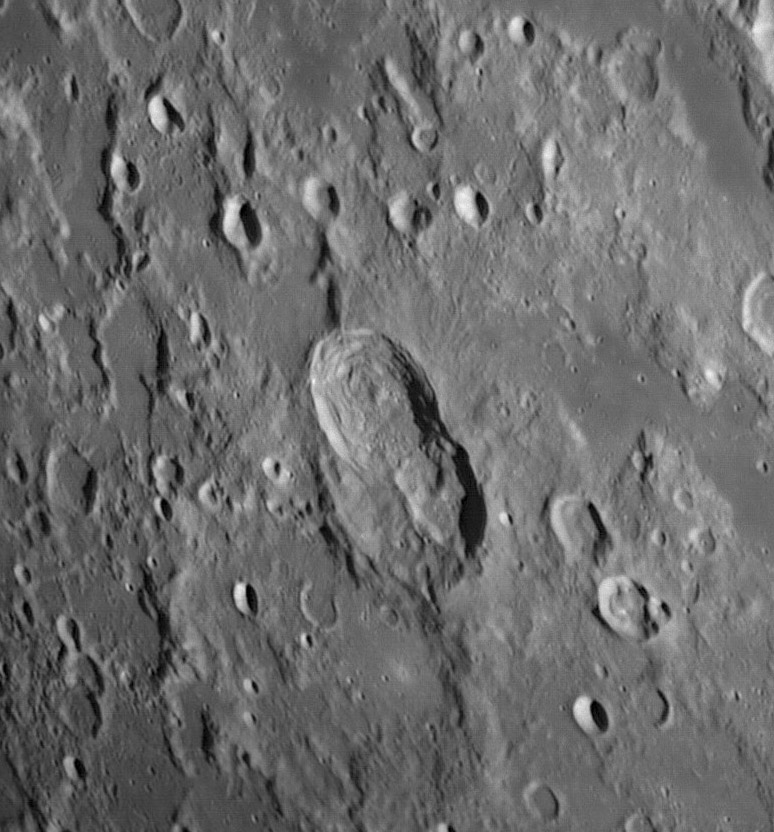April 24, 2008
Mee Three

image by Rafael Benavides, Posadas, Córdoba, Spain
It is very difficult to create an interesting new LPOD every night, especially since nearly every piece of the nearside has been presented and described multiple times over the last 4 plus years. But the images keep getting better, and I learn and thus see more than before. Here is an example. The two fresh craters Hainzel A and C, superposed over the older Hainzel, which is in turn on top of Mee, gave me an opportunity in 2005 to speculate on the stratigraphic relations of these craters and to complain about inappropriate nomenclature. In 2006, late at night, I speculated that Hainzel A was the last fomed from an oblique impact. Again in comets) may have hit the Moon, so we should expect to find some near-simultaneously formed, closely-spaced impact craters. In the 2005 LPOD I speculated that A and C may have formed simultaneously, and now we have a mechanism to explain how it could have happened. I can barely wait for 2009 to see the next generation of great images and to come up with yet another far-out idea.
Chuck Wood
Technical Details
Jan 19, 2008, 21:51 UT. Celestron 11" + Barlow 2x + IR pass filter + Luna QHY-5 mono camera.
Here is Rafael's entire image that this was cut from.
Related Links
Rükl plate 63
Asteroids with Satellites website - fantastic!
Yesterday's LPOD: Count the Pits
Tomorrow's LPOD: Can We Do It Again?
COMMENTS
(1) A friend commented that he often only looks at the LPOD images and that I shouldn't fool myself in thinking that people read the text. How many people buy Playboy to read the interviews, he asks? Well. I write something everyday because I enjoy learning (by looking carefully at the images) and am stimulated by the blank screen under the image that needs some words. Recently, more than 2500 people visit LPOD each day - if the image is all they want, that is fine. And if some want to read the text, that is great too. In fact, I don't think I can not write it!
--Chuck
(2) Chuck--Your commentary is a key part of the LPODs. As an amateur, I enjoy the LPODs as a learning experience. You're the teacher. With your experience, you can see things and explain things in the images that many people no doubt would miss. I enjoy your comments and find them very useful for learning about the Moon.
And, in my case, what I've learned from you--through the LPODs and your book--I've been sharing with others during the slide shows I've been doing about the Moon. Your comments are having "secondary impacts." Don't stop. :)
--Bill
(3) Chuck -- Lots of sites show nice pictures of the Moon, the text for me is the whole point and added value of LPOD, many times your descriptions and questions have caused me to consider certain parts of the moon as targets for my next imaging sessions!
So I second Bill, don't stop!
--Bart
(5) Sorry getting things out of order, but the edit feature doesn't see your comment #4. But I know its there.
I was wondering about the odd shape of the craters and especially those smaller ones in the surrounding area.
I understand that different approach angles can produce such effects, but could also the shape of the land it's hitting? Like hitting a hill might produce a different kind of shape than hitting a piece of flat terra. Just wondering what other elements, aside from speed and approach angels enter into the shape of crater formation.
Aethrae, Andrew Martin SFO
(4) Bill and Bart - Thanks for your appreciation of the text - I do plan on continuing text with LPOD, otherwise what would I do every night - watch TV? But it is true that only a small number of people (about a dozen or so out of 2500 viewers) write comments, so it is altogether possible that my friend is correct that most visitors come for the pictures, and why not - they are usually spectacular. Writing forces me to examine an image more closely and thus learn more about the Moon. And as a former professor I like to explain, so I write for my own pleasure, and its a bonus when some others - a dozen or a multitude - enjoy it too!.
--Chuck
COMMENTS?
Register, Log in, and join in the comments.



